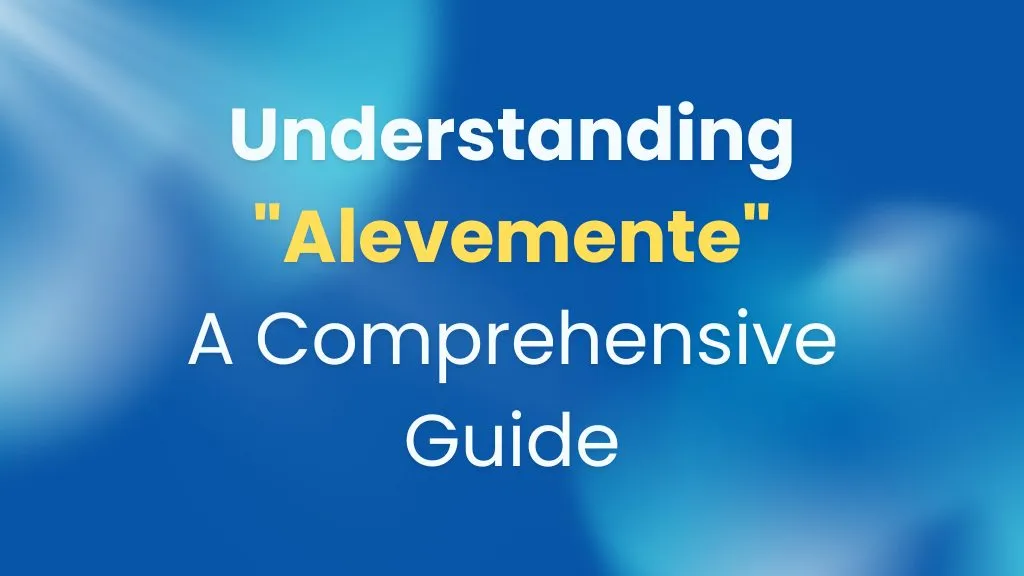The word “alevemente” is a Spanish adverb that translates to “lightly,” “slightly,” or “gently” in English. It describes actions or states characterized by a mild intensity or gentle nature. This term is often used to convey subtlety or delicacy in various contexts. In this article, we will explore the meaning of “alevemente,” its usage in different contexts, and how it can be applied in everyday language. By understanding it better, readers can appreciate its nuances and apply it more effectively in their communication.
What Does “Alevemente” Mean?
Definition and Usage
“Alevemente” is used to describe something done with a light touch or minimal intensity. It emphasizes a subtle or gentle action. For example, if someone speaks “alevemente,” they are speaking softly or gently. Similarly, if a wound is described as bleeding this, it means the bleeding is slight or not severe. This adverb helps convey how actions or states are experienced in a delicate or moderate way, making it an important term for expressing nuances in various situations.
Examples in Sentences
To understand how “alevemente” functions in sentences, consider these examples:
- “La brisa soplaba alevemente sobre el mar,” which translates to “The breeze blew lightly over the sea.”
- “El pastel estaba alevemente decorado,” meaning “The cake was lightly decorated.”
These examples show how it is used to describe actions or conditions that are not intense but rather mild and gentle.
How Is “Alevemente” Used in Different Contexts?
Everyday Situations
In everyday situations, This can describe a range of actions or feelings. For instance, if someone is feeling a little bit sick, they might say, “Me siento alevemente enfermo,” meaning “I feel slightly sick.” Similarly, if you are applying a small amount of lotion, you might do it “alevemente” to ensure you don’t use too much. This term helps convey the degree to which something is experienced or done, making it useful in daily conversations.
Literary and Artistic Contexts
In literature and art, “alevemente” can be used to describe the tone or style of a piece. For example, a poet might describe a scene with “alevemente” to convey a soft, delicate atmosphere. In painting, an artist might use it to describe light brushstrokes or subtle color choices that create a gentle effect. This term adds a layer of description that helps readers and viewers understand the subtlety of the work.
What Are the Benefits of Using “Alevemente”?
Clarity in Communication
Using “alevemente” can enhance clarity in communication by specifying the degree of intensity. For example, if you want to describe how softly someone is speaking, saying they are speaking “alevemente” makes it clear that their tone is gentle. This precision helps avoid misunderstandings and ensures that the listener or reader accurately perceives the intended message.
Expressing Nuance
“Alevemente” allows for the expression of nuance and subtlety. Instead of using broad terms like “soft” or “gentle,” which can be vague, “alevemente” provides a more precise description. This is particularly useful in situations where the exact degree of an action or feeling needs to be communicated, such as in medical descriptions or artistic critiques.
How to Use “Alevemente” in Different Languages?
Spanish Language Usage
In Spanish, “alevemente” is commonly used to describe actions or conditions that are mild or delicate. It fits naturally into sentences where the speaker wants to emphasize the subtlety of an action. For example, “Ella tocó el violín it,” means “She played the violin lightly,” highlighting the gentle touch of the musician.
Translation and Adaptation
When translating “alevemente” into other languages, it is important to choose words that convey a similar level of subtlety. In English, “lightly,” “slightly,” or “gently” are often used. For instance, translating “una sonrisa alevemente triste” to “a slightly sad smile” maintains the nuance of the original Spanish phrase.
What Are Some Common Mistakes with “Alevemente”?
Overuse
One common mistake is overusing “alevemente” in contexts where other adjectives or adverbs might be more appropriate. For example, using “alevemente” to describe something that is clearly more intense or significant can lead to confusion. It is important to use it only when describing actions or conditions that truly match its mild or gentle nature.
Misunderstanding Its Meaning
Another mistake is misunderstanding the meaning of “alevemente.” Since it conveys a subtle degree of intensity, using it to describe something extreme or dramatic can be misleading. Understanding the term’s nuance is crucial for accurate communication.
Conclusion: Understanding “Alevemente”
In conclusion, “alevemente” is a versatile adverb in Spanish that describes actions or conditions with a mild or gentle touch. Its use enhances clarity and expresses nuance in both everyday and artistic contexts. By understanding and applying it correctly, speakers can improve their communication and convey subtlety effectively. This term adds depth to descriptions and helps capture the delicate nature of various situations.
Table: Benefits of Using “Alevemente”
| Benefit | Description |
| Clarity | Provides a precise description of mild or gentle actions. |
| Nuance | Allows for the expression of subtlety and detail. |
| Versatility | Useful in various contexts, including daily conversations and art. |
| Accuracy | Helps avoid misunderstandings by specifying the degree of intensity. |
This article aims to provide a thorough understanding of “alevemente,” offering examples and practical tips for using this term effectively. By exploring its meanings and applications, readers can appreciate the value of this subtle yet significant word.



